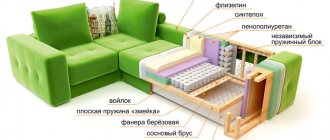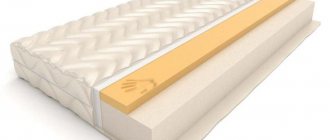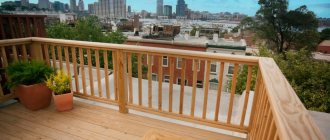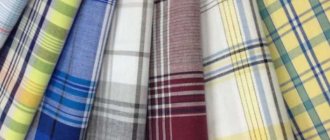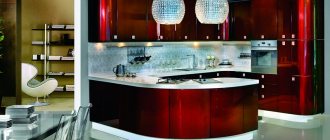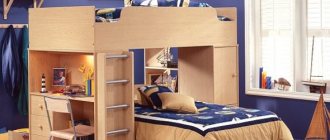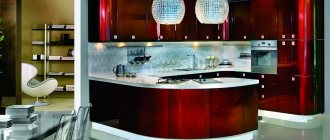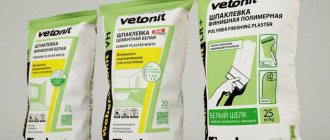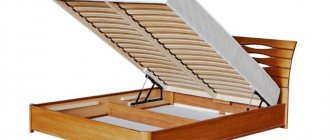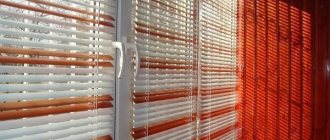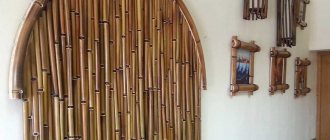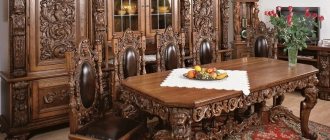The lion's share of modern sofas hides two types of filler under the upholstery: spring blocks or polyurethane foam (PPU). Therefore, when choosing furniture, you should ask what kind of filler, polyurethane foam or springs are inside. Having this information, you can choose the best option not only in appearance, but also in terms of comfort. We will understand what advantages and disadvantages these and other materials have, which affects their convenience and durability.
Flexibility is an important property for upholstered furniture filler Source krovati-i-divany.ru
Advantages of PPU:
- High-quality, dense polyurethane foam serves faithfully for more than 15 years.
- Products made from it have the highest level of hygiene: they do not retain moisture, dry quickly and do not rot; are not a breeding ground for pathogenic bacteria and mold fungi; do not accumulate dust and dust mites. There are practically no insects in them.
- The material does not cause allergic reactions even in the most sensitive people and infants. Does not emit toxic substances when heated and exposed to ultraviolet radiation. It is completely safe for the health of people and pets.
- Quickly returns to its original shape even after extreme compression. Does not deform over time.
- The polyurethane foam surface easily adapts to the contours of the body, perfectly relieving muscle tension and stress from the spine and joints. This sofa provides complete rest and a comfortable night's sleep, no worse than on specialized orthopedic mattresses.
- Thanks to the porous structure, the entire internal contents of the sofa cushions are perfectly ventilated. Air and moisture do not stagnate, which increases the service life of the products.
- It serves as an excellent insulator, so a PPU mattress is always warm and cozy.
Main characteristics
We found out that PPU filler and foam rubber are the same thing. The material is widely used for sofas.
By the way, I have already talked about polyurethane foam mattresses separately, and also discussed the possibility of making simple mattresses from foam rubber with my own hands.
PU sofas are distinguished by the fact that there are no coil springs or other wire blocks in the design. The entire space is occupied by polyurethane foam.
When choosing PU foam filler for a sofa, pillows and other items, focus on the following characteristics:
- Convenience
. This is a priority indicator. During operation, it is important that dents do not form under the human body. In cheap PU sofas this is a disease. Therefore, the quality of the filler must be high. Medium and high-level products are manufactured using special technologies. They are stiffer and also more elastic. They last longer. Can return to their original shape; - Build quality
. The PU foam filler is not inferior in quality and performance characteristics to furniture models with spring blocks. They can be used in any room. Springs may begin to rust when installed in the kitchen or in rooms with high humidity; - Duration of service
. Roughly, PPU lasts for 8 years or more. But at a certain point, the chemical decomposition of polyurethane foam begins. It is irreversible. The released substances become harmful. Therefore, inexpensive models usually do not last more than 10 years. Or you need to completely replace the filler; - Price
. One of the main features of PU foam filling for sofas is the price of the furniture. Good models cost from 10 thousand rubles. An analogue with spring blocks will cost more.
Based on these characteristics, you can decide whether PPU filler is suitable for you or not.
Spunbond
Spunbond (a type of non-woven fabric) is a non-woven fabric obtained by calendering (rolling through hot rollers) polypropylene fibers. Seat and back cushions are wrapped in spunbond This makes it easy to put on fabric covers, as the fabric glides over the spunbond. During operation , spunbond protects soft materials from abrasion and matting, and also allows you to straighten the folds of the cover. fabric is a non-woven fabric used to add volume and strengthen the fabric, prevent stretching of the fabric, reduce wrinkles, do not change the properties of the fabric, and retain the size and shape of the product during use. The inner covers of back cushions and decorative pillows are sewn from spunbond Properties: hypoallergenic (used in the production of hygiene products), non-toxic, tear-resistant, breathable.
Polystyrene balls
Foamed polystyrene - foam balls , a lightweight cellular material consisting of hydrogen and carbon atoms. They are very mobile and do not form friction with each other, which allows products with this filler to quickly take the desired shape. It is a filler for “Bean-Beg” chairs and poufs . The cover is stuffed with many small polystyrene balls. The advantage of the model is its lightness, so if necessary, the chair can be easily moved from room to room. The weight of Bean Bags ranges from one to five kilograms, depending on the size. Made from durable, beautiful fabrics, Bean Bags are filled with extremely lightweight polystyrene foam balls . The balls deform over time under the weight of a person - this is a natural process. At the bottom of each product there is a zipper so that the cover can be washed, or polystyrene foam filler as it shrinks. The use of unique technology has made it possible to rid the products of the accumulation of static charge and rustling, so it is a pleasure to be in them! The filler of Bean Bags is necessarily treated with antistatic agents and components to reduce friction (by 15-20 times) - this is a distinctive characteristic of the filler for poufs. The expanded polystyrene filler does not “creak” and does not accumulate static electricity!
What kind of material is this
Polyurethane foam is one of the types of polystyrene foam (gas-filled plastic). It is produced by foaming a liquid composition, which then hardens.
Polyurethane foam consists of a large number of cells filled with gas - pure carbon dioxide, air or some other. The thermal insulation properties of this material are explained by the fact that it consists of ninety-eight percent gas filling the cells. The remaining small percentage is the solid material itself.
Polyurethane foam furniture can be made in two ways.
- In the first case, parts of the required shape are immediately cast from the material.
- In the second, blocks in the shape of a cube or cylinder are first created, from which blanks are then cut.
The first method is most convenient for assembling sofas, armchairs and other upholstered furniture. This is explained simply.
- Individual molds are used to create parts. Therefore, all parts of the furniture turn out identical and even. No further processing is required.
- When manufactured in this way, the density of the material increases.
But in the production of mattresses, block polyurethane foam is used. Thus, the mattress has less weight, has higher air permeability and the necessary moisture exchange.
Varieties
In the production of sofas, different types of polyurethane foam can be used as filler.
There are the following varieties, as well as types of polyurethane foam:
- Standard
. It is marked ST. Suitable for sofas with a load of up to 80 kilograms. Mainly used for office chairs, backrests, and armchairs; - Increased rigidity
. Or increased density. There are EL and HL markings here. They can withstand loads of up to 100 and more than 100 kg. Recommended for installation in orthopedic mattresses, sofas, as well as folding chairs and children's furniture. They perform well during active use; - Soft
. Withstands a load of no more than 60 kg. Mainly used in additional elements of sofas. These are pillows, headboards, and armrests; - Highly elastic
. It is marked HR. Used in expensive furniture.
Read what the density of foam rubber says in this article
PU foam differs in class and physical and chemical properties.
Also in furniture production, block and cast polyurethane foam can be used in the manufacture of sofas.
Block material is supplied in large blocks. At a furniture factory, polyurethane foam is cut into the required sizes and thickness, and then the sofa padding is formed.
Molded PU foam sheets are solid products that are made in special molds for a specific furniture configuration. The advantage of this method is that there is no waste. Not suitable for non-standard shaped sofas.
How to insulate yourself?
When starting to build or renovate their home, many people think about insulating it themselves without involving specialists. It's actually possible to do this. The main thing is to know the technology of working with polyurethane foam and strictly adhere to it.
Insulation of balconies and loggias
To insulate a balcony or loggia with polyurethane foam, two main methods are used: spraying and pouring. The first method is classic. It is used to treat any surfaces. Chemical components are mixed in a special apparatus. The machine begins to foam the composition, after which it can be sprayed onto clean, dry surfaces of walls, floors, and ceilings.
Liquid polyurethane foam can also be applied by pouring. To do this you will have to build a sheathing. The material is poured between the surface of the balcony wall and the sheathing. After hardening, it forms a strong, durable coating with excellent thermal insulation properties.
Basement
It is better to insulate the basement from the outside during the construction stage of the house. If this has not been done, you will have to work indoors. To simplify and speed up the process, sheet polyurethane foam is used. The work is divided into several stages:
- All surfaces are cleaned of dirt, falling pieces of plaster, and mold.
- A layer of waterproofing is applied. This could be mastic, liquid rubber, bitumen, and so on.
- PPU panels are laid. This can be done using glue. But for reliable and durable installation, it is recommended to use “fungi” dowels.
- After this, you can cover the insulation with finishing materials.
If polyurethane foam spraying is chosen as insulation, then waterproofing is not required. The liquid material penetrates into all cracks, reliably protecting it from aggressive influences.
Walls
Wall insulation is carried out both outside and inside the premises. The first method is preferable. This will allow you to move the area of condensation formation outside the room, preventing the destruction of the structure.
For walls it is recommended to use liquid polyurethane foam. It allows you to create a dense protective coating without joints. The polyurethane foam spraying process is divided into several stages:
- The surface is cleaned of dust and cement deposits. If there are large cracks. They are filled with cement mortar.
- The sheathing is being made. It is better to use wooden blocks for it. The distance between them should be at least 10 cm.
- PPU is being prepared. This can only be done after wearing a protective suit. The two main components are mixed in a special apparatus. It will not be possible to carry out work without it.
- Polyurethane foam should be sprayed onto the walls from bottom to top. The sprayer is kept at a distance of 5-6 cm from the surface.
- After completing the work, remove the spray nozzle and close the taps on the tanks with components.
It is very difficult to carry out such work correctly on your own. In addition, expensive equipment will be required. For a small private house, its purchase turns out to be impractical. Therefore, it is better to seek help from professionals.
Floor
Polyurethane foam is rarely used for floor insulation. This is due to its low vapor permeability. Often after such work a musty smell appears in the room. This material can only be used if there is a warm basement or basement under the floor.
Reviews from professionals recommend using sprayed polyurethane foam most often. The process of installing it is no different from working with walls. The material is also sprayed into the space between the sheathing. After the foam has completely dried, you can proceed to laying the flooring.
Attics and attics
Insulating the roof and walls of the attic allows you to reduce heating costs in winter and avoid a significant increase in temperature in summer. It is extremely difficult for a novice master to carry out such work on his own. Liquid polyurethane foam will need to be applied to vertical walls, as well as to roof surfaces with a negative slope.
Application of the material is allowed only in the warm season. All windows and doors are covered with plastic film. The first layer of sprayed polyurethane foam should have a thickness of about 15 mm. If necessary, after it has completely dried, additional material is applied.
Production
Raw materials for polyurethane foam are products of the petrochemical industry: polyisocyanates and polyols. Also, components for polyurethane foam are made from vegetable oils: castor, rapeseed, soybean, sunflower. Biogenic foam components have not found application in industry, since they require considerable financial investments, and their use is limited to a narrow range of specific tasks.
Chemical reactions take place between petroleum products (polyol and polyisocyanate) mixed in certain proportions. After the first transformations, a small amount of water is added to the reaction mixture, and carbon dioxide begins to be released. The reaction results in foam filled with CO2. The mechanical characteristics and properties of polyurethane, i.e. density and structure, are determined by the size of the chain of gas-filled microgranules, the proportion of the original polymers, and the presence of fire retardant additives.
Filler
The material should be hypoallergenic, and when choosing it, personal preferences should be taken into account. Thus, latex has a healing effect, coconut coir is suitable for those who like hard beds, seaweed will calm the nerves and increase immunity. For sofas, environmentally friendly coconut fiber is considered an ideal option.
In the future, when using it, you need to be very careful when handling the orthopedic sofa with independent spring blocks, and avoid jumping and mechanical influences.
Nature has given us almost a quarter of our lives to rest at night. This is the time when the body rests from stress, recovers and gains strength.
Think about the importance of sleep and choose a sofa or mattress thoughtfully and carefully. Don't waste time and money on your health!
Advantages and disadvantages of spring mattresses
The first spring mattresses appeared quite a long time ago. They were characterized by good properties and impressive endurance. The first samples used springs connected to each other, which provided little back support and also creaked mercilessly, waking up others. Subsequently, spring mattresses with independent spring blocks appeared on the market. They turned out to be almost perfect, which is why they are still produced to this day.
Classic spring mattresses
As we have already said, in classic spring mattresses the springs are intertwined with each other in a kind of network. This was done to provide increased stability to the mattresses, as well as to create a solid foundation for sleeping. However, manufacturers failed to achieve perfection - the finished products were durable, but their orthopedic properties could be argued.
When the springs are connected to each other, they move synchronously, depending on each other. That is, when we lie down on a classic spring mattress, not only the desired springs are compressed, but also the neighboring ones. As a result, the surface of the mattress simply cannot follow the shape of the body. Another result is the brokenness that overcomes us every morning.
The longer we sleep on such a mattress, the longer our body (in particular, the spine) will be exposed to an uncomfortable surface for sleeping. Over time, muscle pain begins to intensify, blood circulation in soft tissues suffers, and we become angry, irritable and sleepy. Spring mattresses do not have orthopedic properties, so they cannot be regarded as a comfortable surface for comfortable sleep. But they are unusually reliable and durable! Now let's look at the advantages and disadvantages of such mattresses.
Advantages
- Long service life - the springs have a large margin of strength, so the mattress will last a long time;
- Cheap – spring mattresses have a low cost, which is a very important advantage;
- Good air exchange - thanks to this, moisture and warm air are quickly removed from the mattress.
Flaws
- Creakiness - the springs rub against each other, creating a squeak that is disgusting to everyone around, which is simply impossible to get rid of;
- Complete lack of orthopedic properties - classic spring mattresses are dangerous to health and sleep.
Spring mattresses with independent spring blocks
Mattresses with independent springs are a more modern development. In them, each spring moves separately from the others, so such mattresses have good orthopedic properties. They provide good support for the spine, allow you to normalize sleep, and are able to follow the contours of the curves of the body.
Independent spring blocks allow you to create an excellent surface for quality sleep. For some, such a surface may seem too hard, but this is just a matter of habit - within a few days after sleeping on a mattress with independent spring blocks, you begin to notice an improvement in the quality of your sleep.
In addition, sleeping on such mattresses is beneficial because the spine retains its correct shape. As for muscle tissue, here we can observe complete preservation of normal blood circulation. Thanks to this, the formation of edema is eliminated, and the unpleasant feeling of numbness in the limbs remains a thing of the past.
Spring mattresses with independent spring blocks are becoming increasingly widespread. But they have a fairly high price. Let's take a closer look at their main advantages and disadvantages.
Advantages
- Excellent orthopedic properties - mattresses with independent blocks provide good back support and help normalize sleep. They are recommended not only for healthy people, but also for people with diseases of the spine and nervous system;
- No squeaks - independent spring blocks do not touch each other, so the appearance of unnecessary noise is practically eliminated.
Flaws
- High cost - compared to classic spring mattresses and polyurethane foam mattresses, which will be discussed later, their cost is quite high, which is due to the complexity of their production;
- Reduced service life - such mattresses are more complex in their design, so they do not tolerate jumps and heavy loads.
Video
What is polyurethane foam?
How to choose a mattress? All about foams (or polyurethane foam, or foam rubber). Consults with GASH master.
Filled polyurethane foam Pouring material into a wall cavity
Let's sum it up
For sofas, PU foam filling is in many ways the optimal solution. It is superior to spring analogues in a number of parameters.
Yes, it has its drawbacks. But there are also significant advantages.
For those interested, in this article you can look at PPU from a more technical point of view. Characteristics of the material, as well as the nuances of its production.
What do you think is the best filling for a sofa? Why did you choose this or that option? What other pros and cons can you highlight?
That's all for me, so I'll say goodbye. Thank you for your attention!
Subscribe, leave a review, and tell your friends about us!
Source
Classification by release form
Polyurethane foam for furniture can also be divided by shape. Products can be:
- roll;
- leafy;
- block;
- acoustic.
The leaf variety has a rectangular shape, and the thickness of the blade can reach 1000 mm. Manufacturers supply such polyurethane foam in standard cuts or take into account individual customer requirements. The roll type comes in reels of different widths. The material is easy to use, and its thickness does not exceed 30 mm.
Characteristics and quality indicators: how to choose a sofa with decent polyurethane foam
How to buy good upholstered furniture filled with high-quality polyurethane foam? First, we look at an indicator such as density. Then you need to check the product yourself before purchasing it in a store.
Density of polyurethane foam
The most important indicator of the quality of polyurethane foam is its density. The denser the filler, the higher its quality and reliability. The optimal value is 30 kg/m3. If the density is lower, it is better to take a closer look at more expensive products. The denser the material, the more durable the furniture will be. But the cost of a sofa with high-density foam will be higher.
Low-density polyurethane foam is often used in backrests and armrests. There is no need to pay attention to this: manufacturers save money, but the sleeping place is of the greatest importance.
The thickness of the polyurethane foam should be 4 cm. Even 3 cm is extremely small for a high-quality filler.
Other factors confirming quality
So, what should polyurethane foam be for a sofa?
- medium in terms of hardness : a too soft option will seem more comfortable at first glance, but the orthopedic properties will be much worse;
- the presence of a homogeneous cellular structure : it is not possible to evaluate - find out about this from the seller in the furniture store or from the manufacturer;
- the ability to quickly return to its original state immediately after pressing : the sofa should not sag.
What is important to check:
- availability of a certificate of conformity : manufacturers of upholstered furniture are required to confirm quality;
- if the sofa has a removable cover, you need to remove it and evaluate the quality of the filling;
- check additional materials, their combination with polyurethane foam, which is often used as one of the layers.
Briefly about the main thing
Upholstered furniture is chosen for more than one season, so when evaluating a model, attention is paid not only to shape and color, transformation mechanism and size. The comfort of any sofa largely depends on what is hidden under the upholstery, which is why it is so important to understand the types and characteristics of the material.
In the production of upholstered furniture, different fillers are used, but the most common are polyurethane foam and springs. Both types meet the requirements of comfort and hygiene, hold the shape of a sofa or chair well, and are designed for approximately the same service life.
In furniture, as an item of long-term use, not only cost is important. Regardless of the filling, both products will be of equal quality if they are made in compliance with the technology. Therefore, you should give preference to manufacturers with a good reputation. It will also be useful to sit or lie on the sofa before purchasing.
Kinds
There are two main types of polyurethane foam:
- closed cell;
- open cell.
The first consists of closed cells that are filled with gas, which ensures expansion of the composition. And this same gas is the key to the low thermal conductivity of the material. This type of polyurethane foam is the most dense and durable.
In addition, it serves as protection against steam, moisture and air. It is more often used for insulation.
Open-cell polyurethane foam consists of elastic cells interconnected. It is not so dense and has a sponge-like structure. But this material is not so durable, so it is not used as insulation.
Positive properties
Mattresses made of polyurethane foam have a number of positive features, thanks to which they have become so widespread.
- If we are talking about mattresses that only partially consist of this material, then the price makes them especially attractive. Their cost is not that high.
- Big choice. Due to its wide distribution, finding a mattress of the size you need or making it to order is not difficult.
- A large number of varieties of material. Thus, it is easy to choose a mattress that will have the properties that are most important to you (different densities, ability to take shape, and so on).
- Due to their softness, such mattresses are easy to roll up and transport.
